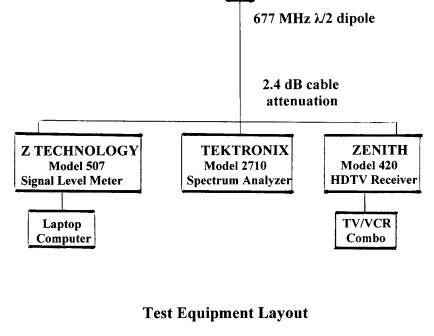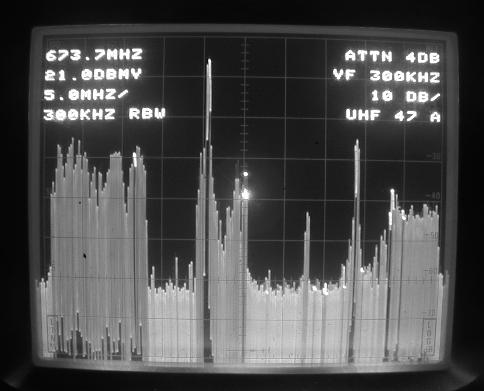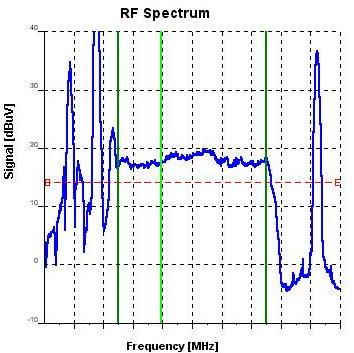
THE BIRO TECHNICAL BULLETINS
MARCH 2005
ON THE VALIDITY
OF THE FCC DEFINED 41 dBu DIGITAL
“NOISE LIMITED SERVICE” SPECIFICATION
FOR DTV COVERAGE
What’s Missing from the 41dBu Standard for HDTV
The very words “Noise Limited Service” imply perfect pictures on the screen of the HDTV receiver, verified by the 41 dBu reading on the fieldstrength meter. During the period of March 1 through March 10, 2005, Biro Engineering of Princeton, N.J. conducted intensive “Noise Limited Service” fieldstrength verification testing in the New York Metropolitan Area for a major CATV MSO to verify the projected 41 dBu service area of a new DTV only station.
What we found made us wonder whether this standard is enough
to ensure optimal picture quality for HDTV customers. An HDTV audience is not interested in dBu fieldstrength, dBuV signal
level or integrated power level recordings. They want real high definition TV pictures, free from frozen images
on their $2,000 HDTV monitor and “NO SIGNAL” messages appearing on the screen.
Four (4) locations were checked on Staten Island, six (6) spots
in Brooklyn and eight (8) measurement locations in Queens, New York. While more than 90% of the tested locations
met or exceeded the Commission’s 41 dBu fieldstrength criteria for “Noise Limited
Contour” service, only at one test site (out of a total of 18 test locations)
were the desired pictures received by the HDTV receiver. However, even at that particular location,
the pictures occasionally froze, and contained artifacts.
There seems to be a missing link between the 41 dBu minimum
fieldstrength criteria and the concept of “Noise Limited Service”: the viewable
HDTV picture.
The Right Testing Methodology
The Metropolitan Area field tests and measurements used the following test equipment and layout.

The Model 507 digital Signal Level Meter produced true integrated power level readings in
dBuV, displaying the 10 MHz wide RF spectrum on the screen of the laptop.
The TEKTRONIX Model 2710 spectrum analyzer was used to check
adjacent channel interference conditions. The
interference reached extremely high levels in most areas because the vicinity
of the Empire State Building, the TV antenna farm of most New York analog and
DTV stations.
Furthermore, HDTV reception was checked with the aid of the
Zenith Model 420 HDTV receiver and the pictures taped by the TV/VCR combo.
A typical adjacent channel interference situation is illustrated on the Signal Direction Sheet below.

The relative angle of interfering Channel 47, New York is only
27° and it is almost 10 times closer
then the desired Channel 48, Kingston.
Projected severe interference conditions were verified with the aid of the TEKTRONIX Model 2710 spectrum analyzer.

The desired 5 MHz (one division) wide DTV spectrum in the center
of the screen is just above the noise level.
The Channel 47 adjacent channel video carrier on the left is more than
50 dB higher than the desired DTV station.
The high level of adjacent channel interference cannot simply
be ignored! UHF tuners exhibit very
limited or no protection against strong adjacent channel carriers. Reaching the demodulator section of the TV
set will create undesired intermodulation products, an increase of the noise
floor and damage to the HDTV pictures.
A second phenomenon, the irregular frequency response of the 5.5 MHz wide DTV power spectrum, will also affect DTV picture quality and the reliability of DTV reception.
 |
 |
FLAT, REGULAR RF RESPONSE |
IRREGULAR RF FREQUENCY RESPONSE |
The RF spectrum on the left, an ideal case of over-the-air
DTV reception, displays a flat, 5.5 MHz wide frequency spectrum. The RF spectrum on the right has a deep notch
and a high peak, caused by reflections and other wave propagation anomalies.
No DTV picture was received at that test location despite the fact that the
measured fieldstrength level exceeded the FCC set minimum fieldstrength of 41
dBu. There are no specifications or
guidelines for acceptable frequency response irregularities, such as peaks and
notches, tilts and deviations from the average fieldstrength
Making Sense of the
FCC Criteria
And last but not least, on the subject of the FCC set criteria
of 41 dBu fieldstrength.
Signal Level Meters, and Spectrum Analyzers provide signal
level readings in dBmV or in dBuV, but not fieldstrength values in dBmicrovolt/meter
(dBu).
Question: What signal
level will produce 41 dBu fieldstrength, as measured at 677 MHz on the half-wavelength
dipole, installed at 30’ above ground?
Signal level to fieldstrength conversions are performed in
two steps. First, convert the dBuV into
dBmV.
The relationship
| dBmV | = |
Next comes the formula establishing the relationship between the dBu fieldstrength and the received dBmV signal level:
| dBu | = |
Where the f is the center frequency of the DTV power spectrum in MHz.
Since our test antenna was a half-wavelength dipole, tuned
exactly to the DTV station’s frequency, there is no need for antenna gain reduction.
On the other hand, a 2.4 dB adjustment for the insertion loss of the
antenna downlead is necessary since the signal level was measured at the end
of the low-loss coaxial cable, not at the dipole’s terminals.
Calculating the received
signal level:
| dBmV | = dBu – (20 * log 677 + 26.32) |
| = 41 – 82.93 |
|
| = -41.93 or -42 dBmV |
Converting -42 dBmV into
microvolts, it is exactly 7.9 microvolts.
If you are under the
impression that this is a very, very low signal level, consider the additional
3 to 6 dB insertion loss on the coaxial cable between the rooftop antenna and
the living room HDTV receiver of the audience.
This will reduce the input signal level for the HDTV receiver to the
more realistic 5.6 or 3.5 microvolts. Those
are extremely low signal levels to produce a reasonably high Signal/Noise ratio,
considering the 7 to 10 dB noise Figure of the UHF tuner in the HDTV receiver.
CONCLUSION
It is not the objective
of this Technical Bulletin to create problems where no problem exists. However,
picture quality limiting factors, such as:
cannot be considered
acceptable engineering practices.
The magic 41 dBu “Noise
Limited Service” requires an honest reexamination. After all, 41 dBu without perfect picture quality is the same as
an iPod without content --it is only scrap metal.
For emergency engineering services:
Call: (609) 883-9866
E-mail: steven@biroengineering.com
Web site: www.biroengineering.com
Biro Engineering
P.O.BOX 2175
PRINCETON, N.J. 08543